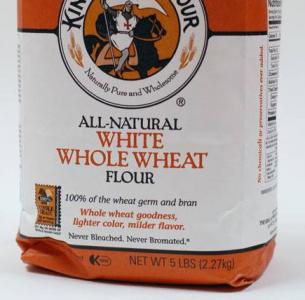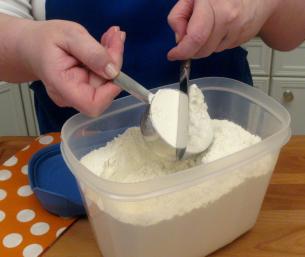There are many different types of flour available in the typical grocery store or supermarket. This post includes a description of some basic flours, and how to measure and store flour.
Here in the USA the following flours are readily available at most grocery stores:
- All-purpose White Flour (bleached or unbleached -see below)
- Enriched Flour
- Wholewheat Flour (and White Wholewheat Flour)
- Bread Flour
- Self-rising Flour
- Cake and Pastry Flour
For most North Americans and Europeans, the word “flour” is synonymous with white wheat flour. But in India, chickpea flour is a cooking staple, in Latin America it’s more common to use maize flour, and in Southeast Asia rice flour is used in many foods.
All flour made from wheat contains gluten, which is the binding agent that gives bread its elastic texture. For anyone with gluten allergies, here’s a handy guide to some alternative flours. There are several great gluten-free cooking blogs on the internet. Here are just a few: Gluten Free Girl Karina’s Kitchen Gluten Free Mommy.
Flour can be made from all kinds of grains, and even fruit and vegetables! Ever heard of banana flour or sweet potato flour?
Flour is used to bake bread, cookies and cakes and also to thicken sauce and gravy, and to coat meat before frying.
All Purpose White Flour
All-purpose white flour is made from processing wheat, leaving out the nutritious germ and bran. It is sold both bleached and unbleached and can be used interchangeably. It is bleached mostly for aesthetic reasons, as flour has a natural yellowish color. The bleaching process also preserves the flour for a longer period of time. Commercial bakers often use unbleached flour.
White flour is also available in organic versions, meaning that it comes from wheat that hasn’t been exposed to pesticides. If you want to substitute all-purpose flour with a different kind of flour, or a non-wheat flour, take a look at this guide.
Enriched Flour
In the USA, the law require that all flour not containing wheat germ must have nutrients added back into the flour. Niacin, riboflavin, thiamin and iron are typically added. Some manufacturers also add Vitamins A and D to the flour as well.
Whole-wheat Flour
Whole-wheat flour is produced from the whole wheat grain, making it more nutritious and fiber-rich than white flour. It also contains more oils than white flour. Consequently, it can go rancid more quickly than white flour. It is best to store whole-wheat flour in the freezer, in a sealed container. Be sure to bring it to room temperature before using it.
You can also buy wholewheat pastry flour at specialty stores or on line. It produces lighter results than regular wholewheat flour, but still not as light as pastries made with white flour.
White wholewheat flour does sound like a contradiction! Nutritionally speaking it is almost the same as whole wheat flour, but lighter-colored and sweeter tasting. Plus you can substitute it for white flour, ounce for ounce and no one would be the wiser.

Photo source: Perfect Pantry
Bread Flour
Bread flour is unbleached flour with a high protein levels and high gluten strength.
Whoa! What does that mean?
Basically when you use it to make bread it gives the bread a better texture than just plain white flour as it reacts really well with yeast.
Self-rising flour (biscuit mix)
This variety of white flour was developed as a time-saving product for cooks. It’s flour that already has baking powder and salt added to it, to help baked goods rise. The baking powder will lose its effect the longer the flour is stored. If you don’t have self-rising flour, you can make it by combining one cup of all-purpose flour with 1.5 teaspoons of baking powder and 1/8 teaspoon of salt.
Cake and Pastry Flour
Cake flour is white flour made from soft varieties of wheat and contains very little gluten. This means that it’s well-suited for cakes, producing a light, airy crumb. Cake flour is usually found in the baking department of the grocery store.
There is also pastry flour, which is used for pie crusts, cookies and other baked goods. It’s not as fine as cake flour. Pastry flour may be available at health food stores.
Measuring flour
Flour is not one of those ingredients that you should eyeball or approximate. If you’re baking, too much flour will make the finished product tough and dry.
In the USA the most standard method to measure is the “dip and sweep” method.
Using a measuring cup, scoop the flour out of the bag or container and then level it off with the straight, dull edge of a knife. Don’t pack it down.
Measuring by weight and not by volume is a much more precise way to measure. All of the recipes here at startcooking.com are based on the “dip and sweep” method as it is what is standard here in the USA.
The following flour weight chart (from The Pie and Pastry Bible by Rose Levy Beranbaum) is a handy reference for baking:
| Flour | Ounces/
cup |
Grams/
cup |
|
|---|---|---|---|
| All Purpose Flour
Bleached |
Sifted
Lightly spooned Dip and Sweep |
4
4.2 5.2 |
114
121 142 |
| All Purpose Flour
Unbleached |
Lightly spooned
Dip and Sweep |
4.5
5.2 |
130
148 |
| Whole Wheat Flour | Sifted
Lightly spooned Dip and Sweep |
4.2
4.5 5.5 |
121
130 157 |
| Bread Flour | Dip and Sweep | 4.5 | 130 |
| Cake Flour | Sifted
Lightly spooned Dip and Sweep |
3.5
4 4.5 |
100
114 130 |
Sifting Flour
Sifting flour incorporates air into the flour and removes any lumps from the flour.
If a recipe says 1 cup of flour, sifted – measure the flour and then sift it.
If a recipe says 1 cup of sifted flour – sift the flour and then measure it.
Storing Flour
If flour is stored in its unopened original package, or in an airtight container, it lasts about eight months. Once it’s open, it’s best to keep it in an airtight container or resealable bag. If you store flour in the fridge, it’s even more important to keep it airtight so that it doesn’t absorb moisture or odors from other foods. The shelf life of the flour will depend on its variety; flours made from whole grains always have shorter shelf life than refined flours. If the flour doesn’t look or smell right, don’t take a chance.
If you’d like to try incorporating wholewheat flour into your baking, here are a few recipes to get you started:
Wholewheat Raspberry Almond Thumbprint cookies are those great little cookies that have a blob of jam in the middle. Thanks, Pinch My Salt!
The Way the Cookie Crumbles demonstrates Wheatmeal shortbread cookies, based on a Martha Stewart recipe.
Here’s a recipe for Whole Grain Bran Muffins, from Farm Girl Fare. Farm Girl swears that they don’t come out tasting like sawdust!
Enjoy!
If you are new to startcooking, or are a regular visitor here, please consider subscribing for free.









































Gail said:
This basic information is so useful. thanks!